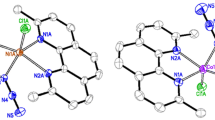Summary
A new binuclear NiII complex, [{(TPA)Ni(μ-Cl)}2]-(ClO4)2·H2O (1), where TPA = tris(2-pyridyl-methyl) amine, has been prepared and characterized. The X-ray crystal structure and variable temperature magnetic susceptibility (4–300 K) of the complex have been determined. The two NiII atoms of (1) are in a distorted octahedral environment and are bridged by Cl atoms. Ni-Cl distances are 2.363(6) and 2.503(7) Å, and the Ni-Cl-Ni angle is 92.7(2)°. The metal atoms are separated by a non-bonding distance of 3.523 Å.
The effective magnetic moment of (1) increases slightly with decreasing temperature and appears to reach a maximum before decreasing. The observed data were fitted to the Heisenberg model and the results indicate that there is a ferromagnetic interaction (positive J) and weak antiferromagnetic intermolecular interaction (negative θ).
Similar content being viewed by others
References
S. W. Ragsdale, Crit. Rev. Biochem. Molec. Biol., 26, 261 (1991).
J. R. Lancaster (Ed.), The Bioinorganic Chemistry of Nickel, VCH Publishers, New York, 1988, chs 13 and 14.
Z. Tyekla'r, R. R. Jacobson, N. Wei, N. N. Murthy, J. Zubieta and K. D. Karlin, J. Am. Chem. Soc., 115, 2677 (1993).
H. G. Jang, D. D. Cox and L. Que, J. Am. Chem. Soc., 113, 9200 (1991).
B. G. Gafford and R. A. Holwerda, Inorg. Chem., 29, 233 (1990).
P. W. Selwood, Magnetochemistry, Interscience, New York, 1956, p. 78.
B. G. Gafford and R. A. Holwerda, Inorg. Chem., 28, 60 (1989).
P. Main, S. J. Fishe, S. E. Hall, L. Lessinger, G. Genain, J. D. Declercq and M. M. Woolfsons, MULTAN 82, A system of computer programs for the automatic solution of crystal structure from X-ray diffraction data, Universites of New York and Louvain, 1982.
D. M. Kurtz, Chem. Rev., 90, 585 (1990).
A. L. Nivorozhkin and H. Toftlund, Transition Met. Chem., 19, 319 (1994).
O. Kahn, J. Galy, P. Tola and M. Coudanne, J. Am. Chem. Soc., 110, 3931 (1978).
C. J. O'Connor, Progr. Inorg. Chem., 29, 203 (1982).
L. J. Bai, J. J. Qiu and Y. T. Chen, Molec. Sci. Chem. Res., 2, 135 (1985).
H. A. Abdel-Magied and J. M. Bellerby, Transition Met. Chem., 19, 141 (1994).
A. B. P. Lever, Inorganic Electronic Spectroscopy, 2nd Edit., Elsevier, Amsterdam, 1984.
Y. Q. Zhou, Analysis of Molecular Structure, Chinese Chem. Ind. Publ. House, Beijing, 1991, p. 80.
Author information
Authors and Affiliations
Rights and permissions
About this article
Cite this article
Zhang, Z.H., Bu, X.H., Zhu, Z.A. et al. Synthesis, magnetism and crystal structure of a chloride-bridged binuclear nickel(II) complex of tris(2-pyridylmethyl)amine. Transition Met Chem 21, 235–237 (1996). https://doi.org/10.1007/BF00165974
Received:
Accepted:
Issue Date:
DOI: https://doi.org/10.1007/BF00165974



